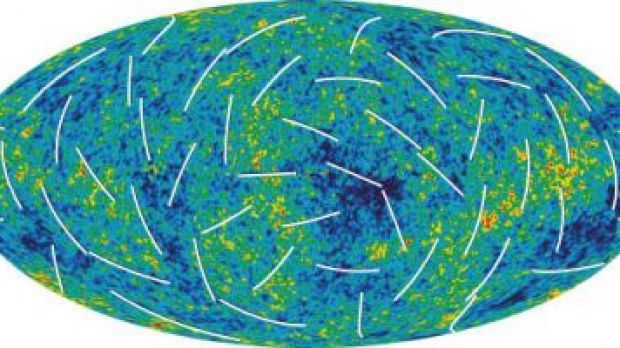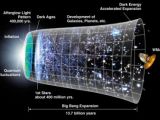According to astronomers, the universe grew from submicroscopic to astronomical size in its first trillionth of a second. This is the conclusion of a new, more detailed picture taken by Wilkinson Microwave Anisotropy Probe (WMAP) - the probe looking for small variations in the cosmic microwave background.
The cosmic microwave background is supposed to be the leftover light from the Big Bang. As the Universe expanded, light "cooled". This idea rises from a correlation between temperature and the wavelength of light - and as the Universe expanded the wavelength stretched more and more.
Besides mapping the variations in the intensity, the probe has now allowed scientists to obtain for the first time information about the polarization of the cosmic microwave background. If one thinks in terms of photons instead of waves, polarization can be understood as an indication about how photons rotate around their own axis - polarization is the orientation of this rotational axis.
In the picture, the colored spots indicate "warmer" (red) and "cooler" (blue). The white bars show the polarization direction of the cosmic background light.
Because this polarization was affected by the first stars, researchers could tell that the first stars emerged about 400 million years after the Big Bang. This is good news, so to speak, because previous estimates were around 200 million years and they didn't seem to leave enough time for the stars to form. But 400 million years is more than enough of a "Dark Age".
According to David Spergel, an astrophysicist at Princeton and member of the WMAP team, they have also been able to obtain a clue about how much of the anisotropy of the background radiation is prior to the formation of the stars and how much is a consequence of the stars.
This has ruled out certain theories of inflation and indicates that the initial expansion of the universe, from zero to more or less the present size, took only about a trillionth of a second, said Brian Greene, a theoretical physicist from Columbia University.
"It amazes me that we can say anything about what transpired within the first trillionth of a second of the universe, but we can," said Charles L. Bennett, WMAP principal investigator and a professor in the Henry A. Rowland Department of Physics and Astronomy at The Johns Hopkins University. "We have never before been able to understand the infant universe with such precision. It appears that the infant universe had the kind of growth spurt that would alarm any mom or dad."
In 2001 WMAP has made headlines as its highly detailed pictures allowed scientists to deduce that the universe is 13.7 billion years old and is "flat" (i.e. neither curved like a gigantic sphere nor outward like a gigantic saddle).
The pictures also convinced most astronomers that much of the matter in the universe is dark matter (a type of matter that supposedly does not interact with photons in any way - but only interacts gravitationally), and that there exists a large amount of dark energy (i.e. an anti-gravitational force responsible for the present day acceleration of the Universe expansion). However, some physicists believe that dark matter and dark energy are more likely signs that our theory of gravitation (Einstein's general relativity) is wrong on large scales.
Pictures credit: NASA/WMAP Science Team

 14 DAY TRIAL //
14 DAY TRIAL // 

